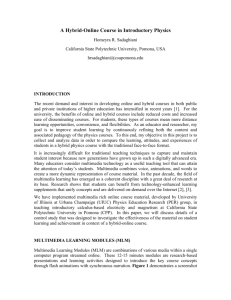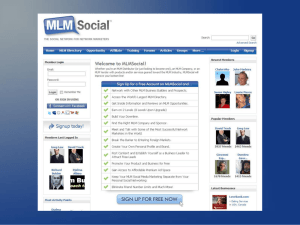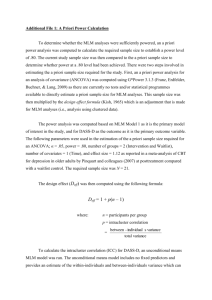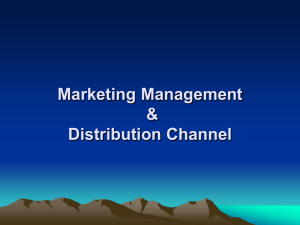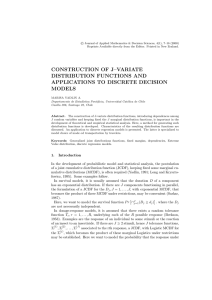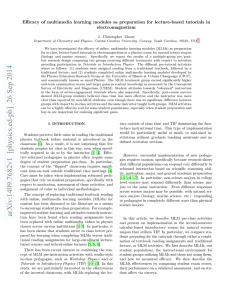Illinois
advertisement
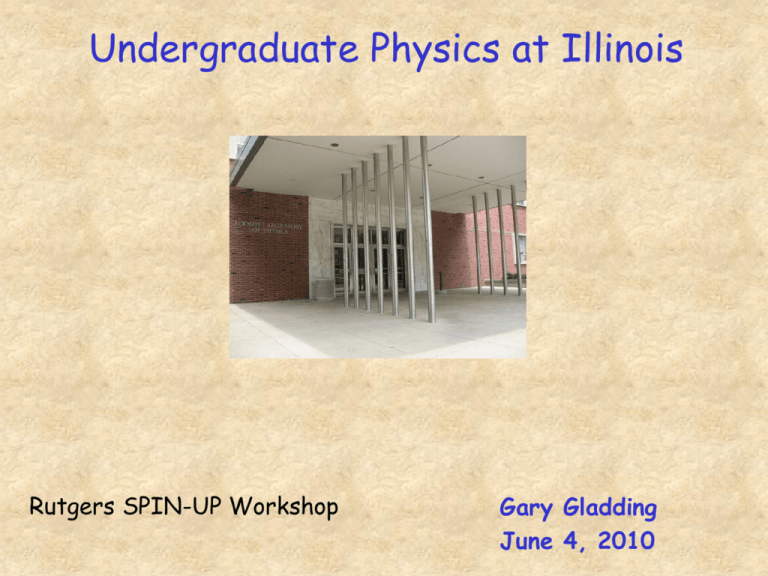
Undergraduate Physics at Illinois Rutgers SPIN-UP Workshop Gary Gladding June 4, 2010 Road Map for Talk • Service Teaching – Reform of Introductory Physics • Physics Majors – Programs and Features • Challenges and New Initiatives? Reforming Intro Physics Instruction Important Constraint : SIZE “Parallel Parking an Aircraft Carrier” Enrollments Algebra-based Calculus-based Fall 900 2250 Spring 850 2550 TOTALS 3150 3400 What Did We Change? OLD (Spring 95) NEW (Spring 01) Lectures Lectures Blackboard/Transparencies Blackboard/Transparencies Demonstrations Demonstrations Discussion TAs TAs work work problems problems on on board board Labs Intellectually disconnected Focus on measurement Predict-Observe-Explain Focus on concepts Homework End of Chapter (paper) Except: one course CAI (NovaNET) WWW-based (TYCHO) Interactive Examples Exams Multi-part Problems Free Response Partial Credit Multiple Choice Created by Faculty Team TA Instruction None Orientation Mentor TAs Observation Note: Most course materials are available by download from: http://research.physics.uiuc.edu/PER/ Powerpoint Powerpoint with with Demos Demos “ACTs” “ACTs” (peer (peer instruction) instruction) Just-In-Time Just-In-Time Teaching Teaching Collaborative Collaborative Learning Learning Common Common Materials Materials created created by by PER PER groups groups or or UIUC UIUC Faculty Faculty I will not go into detail on the nature of these changes here, but will be happy to answer questions later How Was the Plan Created? • Physics committee formed to implement changes – Lemons to Lemonade ! • Improve Teaching Experience (Eliminate Burnout and need for Heroic efforts) • Improve Learning Experience – Focus on Pedagogy and Course Organization (structural change) The Big Idea: Integrate all aspects of a course using interactive engagement methods based on physics education research in a team teaching environment • ONE COURSE !! • Emphasize Concepts – Traditionally, there is a large gap between what we think we are teaching (physics) • – All pieces of the course (lecture, discussion, labs, homework) must be made of the same cloth. The student should see a coherent plan at work. and what is being learned (equation manipulation) Use Interactive Engagement Methods – The learning of physics is NOT a spectator sport; engage the student in ALL aspects of the course! – Make use of the products of Physics Education Research (materials and knowledge). There is a research base here and faculty (esp at a research university) should use it!! Why Did the Change Work and Persist? • Strong Departmental Support – Released Time, Choice of Faculty, new Assoc Head position • Infrastructure created to Facilitate Faculty Participation Guiding Rule: NO HEROES! – Key Ideas – Sustainability cannot be built on heroism – Faculty assignment MUST be seen as an ORDINARY assignment – Infrastructure lowers the bar for participation • Culture Change – “My Course” “Our Course” • Source of Continual Change: The PER Group – Now have faculty whose research activity is to assess reform and created new materials/methods • Interactive Examples (concept-based problem solving web activity) • Multimedia Learning Modules (web-based “prelecture” activity) Multimedia Learning Modules • Multimedia Learning Modules (MLMs) • Module contains essential content of one lecture (~ 15 minutes) • Module ≈ 10 “slides” • “Slide” = Flash movie • Narration plus Animations • Student controls progress of movie (play, pause, repeat, ff, etc..) • Questions: occasionally (2-3 times/module) student is presented with a question • Student answers correctly: given explanation and can proceed • Student answers incorrectly: given feedback and a related question • Once related question answered correctly, original question is represented. • Design of modules guided by principles of multimedia learning • Animations coordinated with Narration • No extraneous visual/auditory material • Minimal text on slide DEMO We are making these prelectures available from: http://research.physics.uiuc.edu/PER/ Results • Clinical Study: • Compared student performance after (i) reading textbook to (ii) interacting with MLMs for the first four units (Coulomb to Gauss) • RESULT: Significantly better performance from MLM students: effect size = 0.7 • Real World Study: • Implemented web-based Multimedia Learning Modules as a “Prelectures” in introductory calculus-based E&M course. • Dramatic improvement in student preparation for lecture • Small improvement in student performance on exams • DRAMATIC improvement in students’ perception of the course. Mechanics course was similarly transformed and offered for the first time Fall09! PRELIMINARY Results look similar to those for E&M! Physics Majors • Curriculum change Fall 2004: – Reduced core physics course requirement to 6 – Added 4 – 6 course “option” that addresses “intellectually coherent body of knowledge”… technical and non-technical options are possible.. 1 option consists of 5 physics courses and one math course designed for preparation for graduate school in physics. • Current Enrollments – Freshmen – Soph – Seniors Physics Undergrad Degrees ~ 100 ~ 200 80 60 50 40 30 20 10 2010 2009 2008 2007 2006 2005 2004 2003 2002 2001 0 2000 Number of Physics Graduates have been increasing over the last 10 years No of degrees granted 70 3 Modern Experimental Physics Lab Networked Digital Scopes Electronic Logbooks Modern Data Analysis Cycles (4.5 weeks each) Experimental rooms Content-expert staff • Nuclear / Particle (NP) – Cosmic ray muons: lifetime, magnetic moment, angular distribution – Nuclear gamma-gamma correlation – Alpha range in gas • Atomic / Molecular / Optic (AMO) QWPs Polarizers – Optical pumping of rubidium gas – QI: Berry’s phase, Quantum erasers, – Entanglement • Condensed Matter (CM) Beam splitter – Superconductivity: • Fabrication & measurements of metal films – 2nd Sound in Helium-4 superfluid state – Pulsed NMR – STM – Polarized optical microscope for ferroelectric expts • Videos of phase transitions Mirrors Senior Thesis (http://physics.illinois.edu/undergrad/seniorthesis.asp) • Three semesters of integrated research & instruction Intro to Physics Research (spring) • Literature Reviews, Estimates,Technical Writing, Presentations, Ethics – Research Experience (summer) – Senior Thesis (fall) • Prepare Scientific Poster • Grad School Preparation • Prepare & Review Research Proposal • Write Thesis Senior Thesis Enrollments – • Symposium in January 25 – Present results 10 5 2009 2008 2007 2006 2005 0 2004 Program began 2002 Increase in 2008 2003 – – 15 2002 • Enrollments No of students 20 Challenges & New Initiative? • Large increase in students: Mech & E&M Last year: additional ~ 500 students in both – Less Faculty – Reduced TA Budget – No New Space • Management of Undergrad Research Opportunities – Summer funding – Faculty Participation – Matching Faculty/Students • Masters Degree in Teaching of Physics (??) – GOALS • Improve preparation of undergrad students taking intro physics • Revenue stream? – Focus on remote delivery to in-service teachers • Improved understanding of pedagogy & fundamental physics That’s All Folks ! That’s All Folks! Initial Experiment • “Clinical” test (limited statistics but controlled environment) • Population: • Students near end of semester course in calculus-based mechanics • Content: Four initial units in E&M course • Coulomb’s Law • Electric Fields • Electric Flux • Gauss’ Law • Treatment Groups: (45 students completed all segments) • Multimedia Learning Module (MLM): 16 students • Scripts (from MLM): 13 students • Text (standard): 16 students • Protocol: • Students do materials and then take test • ~45 minutes per unit (study + ~16 question test) • Students return two weeks later to take retention test (37 questions) Raw Performance Data: Combined Results Retention (Units 1-4) MLM 74.7 ± 2.6 69.7 ± 4.0 71.7 ± 3.0 65.1 ± 3.7 63.2 ± 3.1 56.8 ± 4.1 (N=16) Script (N=13) Text (N=16) Multimedia Learning Module 80% Scripts (from MLM) Textbook 70% 60% 50% Units 1-4 Combined Retention Effect Size: E.S . Effect Size Analysis obey violate Effect Size ~ 1 is Large ! Combined (Units 1 – 4) MLM Text ES = 0.74 p < 0.01 Script ES = 0.36 p = 0.06 Script ES = 0.46 p = 0.03 Retention MLM Text ES = 0.67 p < 0.01 Script ES = 0.45 p = 0.04 Script ES = 0.31 p = 0.16 Correlate with Exam Scores from Mechanics Course The REAL WORLD Clinical test looks good! BUT PHYS 212 SPRING 2008 present PHYS 212 Before SPRING 2008 JiTT Preflights (few read text) LECTURE 75 minutes Narrative + Peer Instruction What about a real course?? MLMs implemented as “Prelectures” (initial exposure to material) CHANGES JiTT Preflights (formative assessment) LECTURE 50 minutes Highly Interactive (8 – 10 clicker questions) Preflight Assessment • Repeated Preflight Questions allow for assessment The Viewing Habits of Students • Plot the time spent by each student on a prelecture audio narration time Preflight Assessment Results for Non-Viewers Look Like Those from Pre-MLM Preflight Assessment MLMs Benefit Students of All Abilities Main Plots: Viewers Inserts: Non-Viewers Lectures: The PAYOFF • Lectures are qualitatively different now ! – Better prepared students means more engaged students ! • Current lecture plan First half • Mini-lectures and ACTs based on student difficulties observed in preflights – Second half • ACTs based on solution to quantitative problem – • More Interaction – The OLD: ~ 3 ACTs in 75 minutes – The NEW: ~ 8 ACTs in 50 minutes Lecture Slides Available from: http://online.physics.uiuc.edu/courses/phys212/fall09/lectures.html Exam Analysis We have modified the lecture experience No changes have been made to highly valued homework & discussion components Do we see any improvement in exam performance?? Low expectations: Time (Prelecture+Lecture) ~ 30% Time (Homework+Discussion) Hour Exam 1: Repeat exam from Fall 1998 <Fall 98> = 72.1 ± 0.5% <Fall 08> = 76.5 ± 0.5% Effect Size = 0.30 p < .01 Similar results for all three midterms (Spring08) d ~ 3% ES ~ 0.2 Somewhat smaller results for Final Exams d ~ 1 - 3% ES < 0.2 Student Perceptions End of Term Survey: Students asked to rate items on a 5 point scale Example: Rate this course in terms of difficulty (1: one of easiest, 3: average, 5: one of most difficult) Plot fraction of students who responded with 4 or 5 Student Perceptions End of Term Survey: Students asked to rate items on a 5 point scale Example: Rate this course in terms of difficulty (1: one of easiest, 3: average, 5: one of most difficult) Plot fraction of students who responded with 4 or 5 Student Perceptions End of Term Survey: Students asked to rate items on a 5 point scale Plot fraction of students who responded with 4 or 5 Student Perceptions End of Term Survey: Students asked to rate items on a 5 point scale Plot fraction of students who responded with 4 or 5 Student Perceptions End of Term Survey: Students asked to rate items on a 5 point scale Plot fraction of students who responded with 4 or 5

